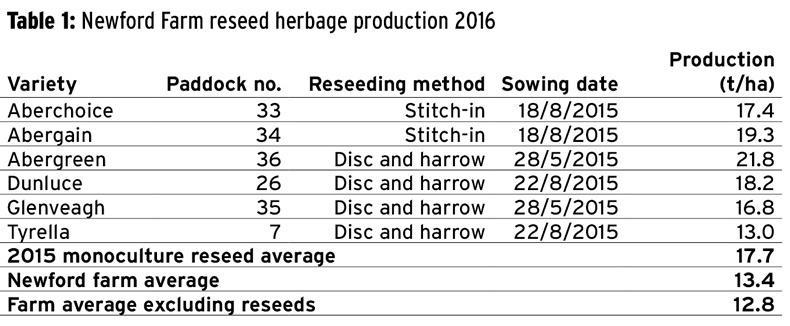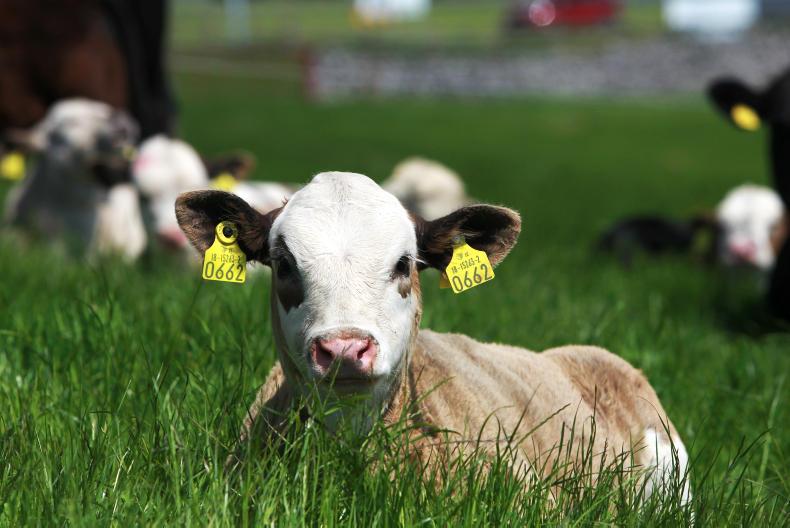At various stages in 2015, six paddocks on the Newford Demonstration Farm were reseeded with different varieties of perennial ryegrass. These were monoculture reseeds, meaning that a single variety, as opposed to a mixture, was sown in each paddock. After their first full year of production, we can compare each in terms of grass production using data from Teagasc’s Pasturebase system.
Table 1 lists each variety, the paddock it was sown in, the reseeding method and date, and the paddock’s total herbage production for 2016.

The varieties
The term ploidy refers to the genetics of the grass. Tetraploids are seen as being of higher quality to diploids and more appealing to livestock (potential for higher intakes). They are also more tolerant to excessively dry weather. The catch is that tetraploids are less dense on the ground than diploids, leading to more open swards. Tetraploid-dominant swards can be difficult to manage and maintain on heavy soils.
Aberchoice is a late-heading diploid with a 9 June heading date. It is characterised as being highly digestible and having excellent production potential in the autumn. Abergain is a tetraploid variety – again, late heading (5 June). It is exceptionally strong for spring growth.
Abergreen is an intermediate-heading (28 June) diploid with excellent ground cover. Dunluce is an intermediate heading tetraploid with a 30 May heading date. It is described as having good autumn growth and digestibility and a moderate ground cover score. Glenveagh is a late-heading (June 2) diploid with an excellent ground cover score. Tyrella is another late-heading (June 4) diploid, with very good spring growth and moderate autumn/summer production.
Analysis
Newford Farm’s average paddock produced 13.4t of herbage between 1 January and 31 December 2016. The monoculture reseeds carried out in 2015 produced an extra 3.3t on top of this. Indeed, if we discount the figures for paddock seven, which farm manager Matthew Murphy describes as “poor ground which was damaged during the construction of the adjoining motorway”, the reseed average jumps to 18.7t. That said, this poor ground still grew over 60% more grass than the average hectare on an Irish drystock farm in 2016. This is a credit to the Newford team and shows just what can be achieved when soil fertility and grassland management are optimised.
Winner
Abergreen leads the way in terms of tonnage, having produced 21.8t of grass dry matter in 2016. Indeed, the same variety became only the second forage grass to win the Variety Cup from the National Institute of Agricultural Botany (UK) in 2015, which recognises varieties from agricultural, horticultural or ornamental sectors that have made a major contribution to crop productivity through improved quality, disease resistance, grower return or commercial success.
It will be interesting to follow the paddock’s progress in the future – can it can keep up these eye-watering levels of production? Will there be downsides? Also of note is the fact that the stitched-in reseeds held their own compared with the more conventional disc and harrow methods.
The average Irish drystock farm grows around 8t of grass dry matter annually and utilises less than 6t of this. Every extra tonne of grass dry matter utilised on drystock farms is worth an extra €105 net profit. Results like these at Newford demonstrate the potential that is there to make grass gains. However, reseeding is not to be considered before soil fertility (lime, P and K) is optimised.






 This is a subscriber-only article
This is a subscriber-only article











SHARING OPTIONS: